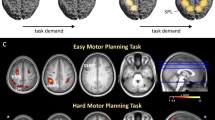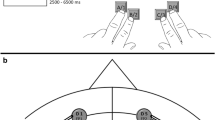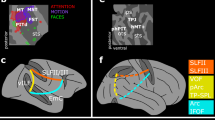Abstract
When task instructions are given, the human brain establishes a task set before the task is actually performed. By introducing a delay between the instruction and the task, we have identified the neural correlates of task sets using functional magnetic resonance imaging (fMRI). Subjects were instructed to remember a sequence of positions or letters, either in the order presented or in the reverse order. Spatial or verbal processing areas were active during the delay, depending on whether positions or letters were to be remembered, whereas the anterior region of the prefrontal cortex (PFC) was active regardless of the domain of the items. Furthermore, the nature of the interaction between the anterior PFC and the domain-specific posterior prefrontal areas (superior frontal sulcus and left inferior frontal gyrus) depended on whether the items were to be remembered in the forward or backward order. Thus we have identified inter-regional interactions that reflect preparation for task performance.
This is a preview of subscription content, access via your institution
Access options
Subscribe to this journal
Receive 12 print issues and online access
$209.00 per year
only $17.42 per issue
Buy this article
- Purchase on Springer Link
- Instant access to full article PDF
Prices may be subject to local taxes which are calculated during checkout






Similar content being viewed by others
References
Rogers, R.D. & Monsell, S. Costs of a predictable switch between simple cognitive tasks. J. Exp. Psychol. Gen. 124, 207–231 (1995).
Corbetta, M. & Shulman, G.L. Control of goal-directed and stimulus-driven attention in the brain. Nat. Rev. Neurosci. 3, 201–215 (2002).
Wilson, F.A., Scalaidhe, S.P. & Goldman-Rakic, P.S. Dissociation of object and spatial processing domains in primate prefrontal cortex. Science 260, 1955–1958 (1993).
O'Scalaidhe, S.P., Wilson, F.A. & Goldman-Rakic, P.S. Areal segregation of face-processing neurons in prefrontal cortex. Science 278, 1135–1138 (1997).
Ungerleider, L.G., Courtney, S.M. & Haxby, J.V. A neural system for human visual working memory. Proc. Natl. Acad. Sci. USA 95, 883–890 (1998).
Kurata, K. & Wise, S.P. Premotor cortex of rhesus monkeys: set-related activity during two conditional motor tasks. Exp. Brain Res. 69, 327–343 (1988).
Crammond, D.J. & Kalaska, J.F. Prior information in motor and premotor cortex: activity during the delay period and effect on pre-movement activity. J. Neurophysiol. 84, 986–1005 (2000).
Calton, J.L., Dickinson, A.R. & Snyder, L.H. Non-spatial, motor-specific activation in posterior parietal cortex. Nat. Neurosci. 5, 580–588 (2002).
Schlag-Rey, M., Amador, N., Sanchez, H. & Schlag, J. Antisaccade performance predicted by neuronal activity in the supplementary eye field. Nature 390, 398–401 (1997).
MacDonald, A.W., Cohen, J.D., Stenger, V.A. & Carter, C.S. Dissociating the role of the dorsolateral prefrontal and anterior cingulate cortex in cognitive control. Science 288, 1835–1838 (2000).
Sakai, K., Rowe, J.B. & Passingham, R.E. Active maintenance in prefrontal area 46 creates distractor-resistant memory. Nat. Neurosci. 5, 479–484 (2002).
Asaad, W.F., Rainer, G. & Miller, E.K. Task-specific neural activity in the primate prefrontal cortex. J. Neurophysiol. 84, 451–459 (2000).
Wallis, J.D., Anderson, K.C. & Miller, E.K. Single neurons in prefrontal cortex encode abstract rules. Nature 411, 953–956 (2001).
Kastner, S., Pinsk, M.A., de Weerd, P., Desimone, R. & Ungerleider, L.G. Increased activity in human visual cortex during directed attention in the absence of visual stimulation. Neuron 22, 751–761 (1999).
Düzel, E. et al. Task-related and item-related brain processes of memory retrieval. Proc. Natl. Acad. Sci. USA 96, 1794–1799 (1999).
Lepage, M., Ghaffar, O., Nyberg, L. & Tulving, E. Prefrontal cortex and episodic memory retrieval mode. Proc. Natl. Acad. Sci. USA 97, 506–511 (2000).
Rugg, M.D. & Wilding, E.L. Retrieval processing and episodic memory. Trends Cogn. Sci. 4, 108–115 (2000).
Rushworth, M.F.S., Passingham, R.E. & Nobre, A.C. Components of switching intentional set. J. Cogn. Neurosci. (in press).
Owen, A.M. et al. Redefining the functional organization of working memory processes within human lateral prefrontal cortex. Eur. J. Neurosci. 11, 567–574 (1999).
Postle, B.R., Berger, J.S. & D'Esposito, M. Functional neuroanatomical double dissociation of mnemonic and executive control processes contributing to working memory performance. Proc. Natl. Acad. Sci. USA 96, 12959–12964 (1999).
Rowe, J.B., Toni, I., Josephs, O., Frackowiak, R.S.J. & Passingham, R.E. The prefrontal cortex: response selection or maintenance within working memory? Science 288, 1656–1660 (2000).
Leung, H.C., Gore, J.C. & Goldman-Rakic, P.S. Sustained mnemonic response in the human middle frontal gyrus during on-line storage of spatial memoranda. J. Cogn. Neurosci. 14, 659–671 (2002).
Wylie, G. & Allport, A. Task switching and the measurement of 'switch costs'. Psychol. Res. 63, 212–233 (2000).
Meiran, N., Chorev, Z. & Sapir, A. Component processes in task switching. Cognit. Psychol. 41, 211–253 (2000).
Rogers, R.D. et al. Dissociating executive mechanisms of task control following frontal lobe damage and Parkinson's disease. Brain 121, 815–842 (1998).
Shallice, T. & Burgess, P.W. Deficits in strategy application following frontal lobe damage in man. Brain 114, 727–741 (1991).
Burgess, P.W., Veitch, E., de Lacy Costello, A. & Shallice, T. The cognitive and neuroanatomical correlates of multitasking. Neuropsychologia 38, 848–863 (2000).
Duncan, J., Emslie, H., Williams, P., Johnson, R. & Freer, C. Intelligence and the frontal lobe: the organization of goal-directed behavior. Cognit. Psychol. 30, 257–303 (1996).
Pochon, J.-B. et al. The role of dorsolateral prefrontal cortex in the preparation of forthcoming actions: an fMRI study. Cereb. Cortex 11, 260–266 (2001).
Baker, S.C. et al. Neural systems engaged by planning: a PET study of the Tower of London task. Neuropsychologia 34, 515–526 (1996).
Dagher, A., Owen, A.M., Boecker, H. & Brooks, D.J. Mapping the network for planning: a correlational PET activation study with the Tower of London task. Brain, 122, 1973–1987 (1999).
Burgess, P.W., Quayle, A. & Frith, C.D. Brain regions involved in prospective memory as determined by positron emission tomography. Neuropsychologia 39, 545–555 (2001).
Christoff, K. & Gabrieli, J.D. The frontopolar cortex and human cognition: evidence for a rostrocaudal hierarchical organization within the human prefrontal cortex. Psychobiology 28, 168–186 (2000).
Fletcher, P.C. & Henson, R.N.A. Frontal lobes and human memory. Brain 124, 849–881 (2001).
Friston, K.J., Holmes, A.P., Price, C.J., Büchel, C. & Worsley, K.J. Multisubject fMRI studies and conjunction analyses. Neuroimage 10, 385–396 (1999).
Acknowledgements
This study was supported by the Wellcome Trust. K.S. was supported by the Human Frontier Science Program.
Author information
Authors and Affiliations
Corresponding author
Ethics declarations
Competing interests
The authors declare no competing financial interests.
Rights and permissions
About this article
Cite this article
Sakai, K., Passingham, R. Prefrontal interactions reflect future task operations. Nat Neurosci 6, 75–81 (2003). https://doi.org/10.1038/nn987
Received:
Accepted:
Published:
Issue Date:
DOI: https://doi.org/10.1038/nn987
This article is cited by
-
Theta Oscillations Support Prefrontal-hippocampal Interactions in Sequential Working Memory
Neuroscience Bulletin (2024)
-
Reconceptualizing mind wandering from a switching perspective
Psychological Research (2023)
-
Brain correlates of action word memory revealed by fMRI
Scientific Reports (2022)
-
Computational models of adaptive behavior and prefrontal cortex
Neuropsychopharmacology (2022)
-
Reward-related choices determine information timing and flow across macaque lateral prefrontal cortex
Nature Communications (2021)



